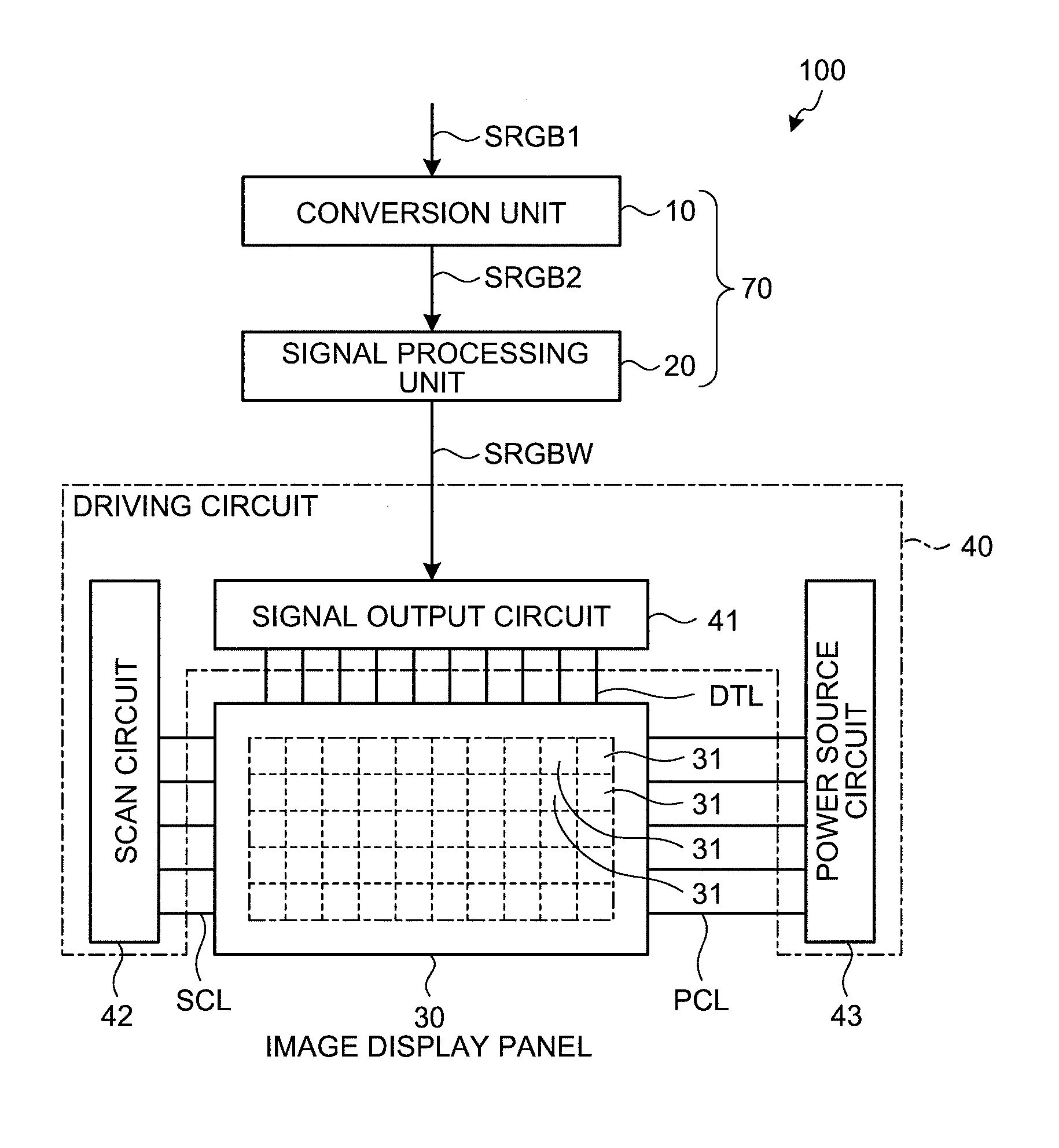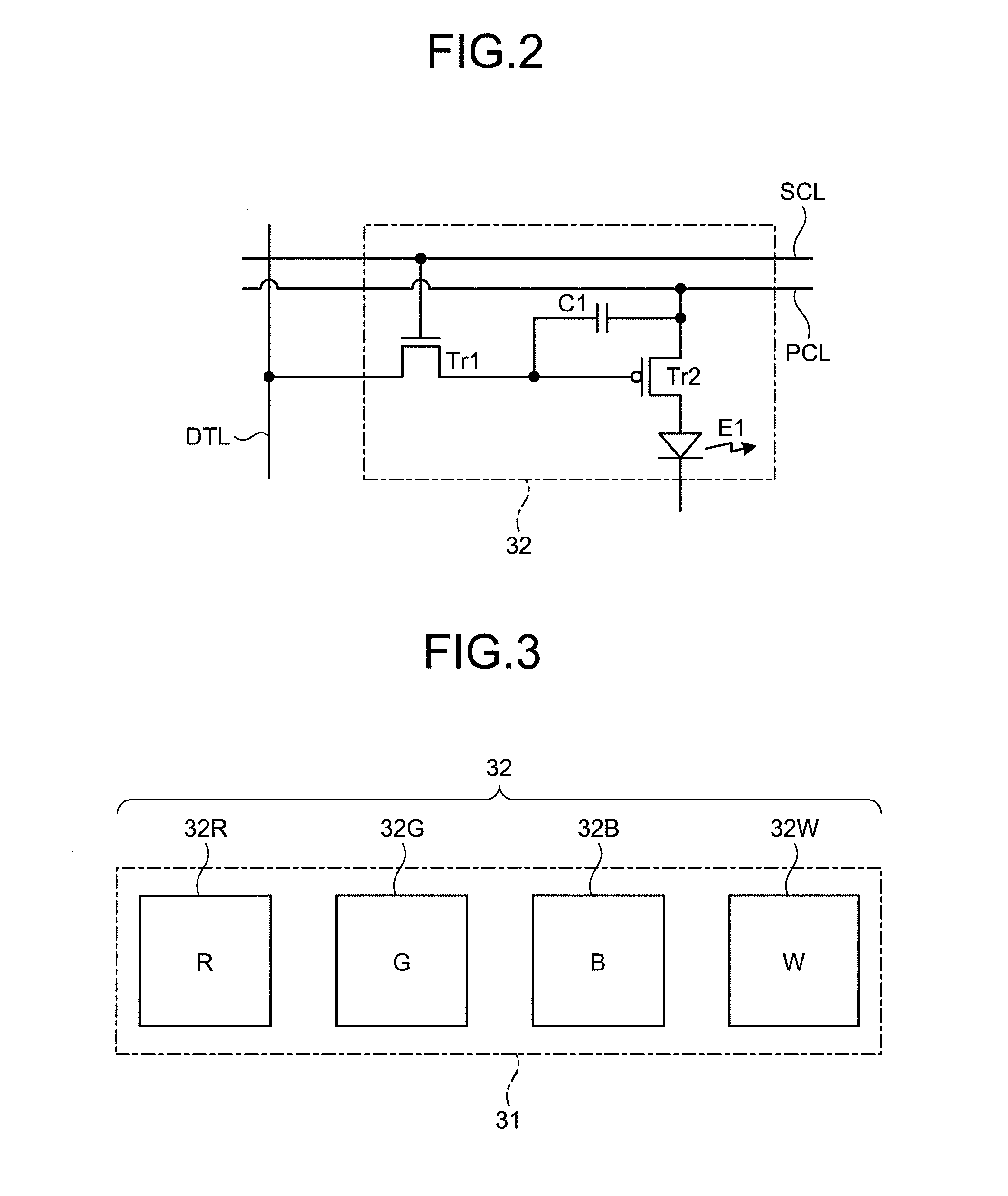Image processing device, display device, electronic device and method for processing an image
a technology of image processing and display device, applied in the field of image processing device, display device, electronic device and image processing method, can solve problems such as degradation of display image, and achieve the effects of reducing power consumption, reducing luminance in the range, and reducing power consumption
- Summary
- Abstract
- Description
- Claims
- Application Information
AI Technical Summary
Benefits of technology
Problems solved by technology
Method used
Image
Examples
first embodiment
[0054]A first embodiment is explained in detail below with reference to the accompanying drawings.
[0055]FIG. 1 is a schematic block diagram illustrating a configuration of the display device according to an embodiment. FIG. 2 is an exemplary diagram of a lighting drive circuit of a pixel including sub-pixels of an image display portion according to the embodiment. FIG. 3 is an exemplary diagram of arrangement of sub-pixels of the image display portion according to the embodiment. FIG. 4 is a cross-sectional view of the image display portion according to the embodiment.
[0056]As illustrated in FIG. 1, a display device 100 includes an image processing unit 70, an image display portion (image display panel) 30, an image display panel driving circuit 40 (hereinafter, referred to a driving circuit 40 as well) for controlling a drive of the image display panel 30. The image processing unit 70 includes a conversion unit 10 and a signal processing unit 20. The conversion unit 10 and the sign...
modification 1
[Modification 1]
[0100]Now, a modification 1 of the first embodiment is described below. The modification 1 is different from the first embodiment in that luminance attenuation ratio is calculated according to saturation. FIG. 10A is schematic diagram illustrating a relationship between saturation and luminance according to modification 1. FIG. 10B is schematic diagram illustrating a relationship between saturation and luminance attenuation ratio according to modification 1. FIG. 11A is a color pattern image prior to image processing method according to the embodiment. FIG. 11B is a color pattern image subsequent to image processing according to the first embodiment. FIG. 11C is a color pattern image subsequent to image processing method according to the modification 1.
[0101]In FIG. 10A, a vertical axis stands for luminance and a horizontal axis stands for saturation. In FIG. 10A, a line ‘c’ indicates a relationship between saturation and luminance under hue B. Here, hue B is not lim...
second embodiment
[0107]Now, second embodiment is described in detail below. FIG. 13 is schematic diagram illustrating a relationship between saturation and luminance attenuation ratio with various hues. FIG. 14 is a flowchart illustrating an image processing method according to a second embodiment. The second embodiment is different from the first embodiment in that a relationship between saturation and luminance attenuation ratio are stored associated with hue and luminance attenuation ratio is obtained on the basis of the identified hue and saturation. Elements substantially identical in function and configuration as those of the first embodiment are denoted by like reference numerals, and points where the modification differs from the first embodiment are mainly described below.
[0108]As described above, generally, the smaller saturation is, the higher luminance is because of coming close to a white. The greater saturation is, the lower luminance is. Furthermore, luminance varies in accordance wit...
PUM
 Login to View More
Login to View More Abstract
Description
Claims
Application Information
 Login to View More
Login to View More - R&D
- Intellectual Property
- Life Sciences
- Materials
- Tech Scout
- Unparalleled Data Quality
- Higher Quality Content
- 60% Fewer Hallucinations
Browse by: Latest US Patents, China's latest patents, Technical Efficacy Thesaurus, Application Domain, Technology Topic, Popular Technical Reports.
© 2025 PatSnap. All rights reserved.Legal|Privacy policy|Modern Slavery Act Transparency Statement|Sitemap|About US| Contact US: help@patsnap.com



